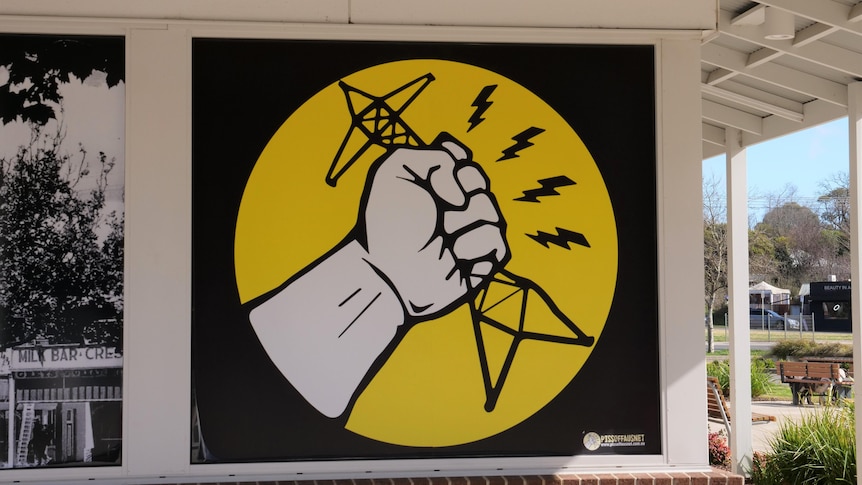The mouth-watering scent of freshly baked baguettes mingles with irresistible wafts of buttercream and powdered sugar.
Smartly dressed customers alternate delicate bites of mille-feuille with sips of café.
Everything about Creswick’s Le Péché Gourmand Boulangerie-Patisserie whispers provincial France, but a bold red sign in the corner of the shop front screams western Victoria:
“Stop AusNet’s Towers. Join the fight.”
The town and surrounding district’s push to halt plans to construct above-ground powerlines for AusNet’s Western Renewables Link has been running for years.
Handmade protest signs are fixtures on farm gates, fences, and in businesses throughout the region; even the Big Spud on Ballarat-Daylesford Road has its own “Piss Off AusNet” placard.
In March, local farmers opposing the project rallied at Parliament House in Melbourne, and most recently drove tractors through Ballarat’s CBD.
Le Péché Gourmand co-owner Marie Williams says she fears it is these farmers who could pack up and leave the region if AusNet’s plans go ahead and, consequently, crush her customer base.
“We’re really worried about it, to be honest,” Ms Williams said.
“If the farmers aren’t there anymore, we lose half our customers.”
Ms Williams and her husband moved from Sydney to Creswick 10 years ago to escape city life. She said the Western Renewables Link would puncture the town’s bucolic surrounds with unsightly towers, turning off tourists.
“Looking at towers isn’t the most pleasant thing. It’s hard to grasp how far it’ll go and how much it’s going to affect the region,” she said.
More transmission lines on the horizon
Last week further plans for another transmission line through western Victoria were released by AEMO (Australian Energy Market Operator) and Transgrid.
Pitched as a once-in-a-lifetime opportunity by the energy operators, the Victoria to New South Wales Interconnector West (VNI West) power link aims to allow the two states to share electricity.
AEMO spokesperson Jonathon Geddes said the development would “increase network resilience, energy reliability and put downward pressure on electricity prices for homes and businesses”.
Councils divided
Under the plan, 500 kilovolt (kV) double-circuit overhead transmission lines would snake from the Snowy Hydro grid in New South Wales, through to a proposed terminal station at Newlyn, in the Hepburn Shire.
Ruth McRae, the mayor of Murrumbidgee Shire Council in the Riverina, said the council “fully supports strategies to generate and deliver affordable and secure energy to our nation.”
“Energy costs form a large part of the household budget so most people would support this concept,” Councilor McRae said.
She stressed, however, that the project’s “greatest impacts are borne by local landholders and community.”
“This project affects us all and we urge the community to get involved with the consultation process and make their views known,” she said.
Hepburn Shire Council — which takes in the towns of Clunes, Creswick, Daylesford, Hepburn Springs and Trentham — has voiced strong opposition to the proposal, echoing its stance on the Western Renewables Link.
Deputy Mayor Jen Bray told ABC Ballarat Breakfast the council was “not opposed to renewable energy”, but how it was delivered was important.
She said the council was seeking an underground solution for the powerlines, along with a different location for the transmission station proposed for Mount Prospect in the village of Newlyn.
“It’s going to set up Hepburn Shire as a central hub for a series of lines that could be radiating out, much like the spokes of a cartwheel,” she said.
“It’s not really what you want in an area where you’ve got high-quality, premium agricultural land.
“It’s not what you want in an area where your main tourism economy is reliant on beautiful, pristine landscapes.”
But Mr Geddes said high-voltage underground lines along the full length of the project was “not economically justifiable”.
“We acknowledge the importance of considering all reasonably practicable route refinement options, which may, in exceptional circumstances, include partial undergrounding short distances,” he said.
Projects ‘can be done better’
If the projects come to fruition as planned, Newlyn potato farmer Kain Richardson’s property will be surrounded by transmission lines, and have the VNI West transmission station at his “back doorstep.”
“There’s been no consideration given to the people,” he said.
Mr Richardson, a fifth-generation farmer, said neither proposal was utilizing “modern-day technology”.
“We’ve moved on from the time [transmission towers] were built in the 1960s. Do you want to go back to leaded cars?” he asked.
“Why is transmission being left out of the technology advancements, and landholders have to accept that? It’s not on.”
Mr Richardson said he was yet to receive any communication from AEMO or Transgrid about the VNI West project since the project assessment draft report was released.
“It leaves a lot to be desired,” he said.
AEMO Victorian Planning and Transgrid will hold online information sessions on August 10 and August 25. Registration is required.
.
